Aligning SEO Efforts with Audience Needs and Expectations
- Why Your Audience Should Drive Your SEO Strategy
- Understanding Search Intent Is Everything
- SEO Landscape is Changing Fast in 2025
- Creating Content That Matches Audience Expectations
- Technical SEO Still Matters (But Not How You Think)
- Measuring What Actually Matters
- Building an Audience-First SEO Strategy
- SEO Has to Align with Audience Needs

A question for you…
Ever wonder why most SEO strategies fail?
It’s not because of poor keywords or weak backlinks. The real problem is that businesses forget who they are actually writing for… Real people with real needs.
91% of marketers report that SEO improves website performance and marketing objectives. But here’s the catch – those great results only come when your SEO efforts align with the needs of the audience.
In this post, we’re going to cover:
- Why does audience alignment matter for SEO?
- The role of search intent
- Creating content that converts
- Success metrics that actually matter
Why Your Audience Should Drive Your SEO Strategy
Here’s something most businesses get wrong…
Optimizing content and pages for search engines first and people second. Search engines (read: Google) have one job – to connect people with the content they are looking for.
When a person searches for “best running shoes for flat feet” they don’t want to read some generic article. They have a specific problem and want a specific solution.
This is where working with a cutting-edge SEO services agency makes all the difference. The best agencies understand that optimization is not just about ranking. Optimization is about serving your audience at every stage of their journey.
Alignment with audience intent also happens with some of the best agencies. The best SEO agencies don’t just stuff keywords and focus on link building. They work with content that maps to audience pain points and searches.
It’s not a surprise then that 82% of B2B content marketers think that knowing the audience is the most important factor for content marketing success. Not keyword density. Not link building. Knowing who you are talking to.
Understanding Search Intent Is Everything
Let me show you why this matters so much…
Research indicates that 70% of all search traffic is generated from informational queries.
Most people are not ready to buy. They are just looking for information, solutions and answers.
Intent is broken down into four categories and you need to hit all of them.
- Informational Intent: People want to learn or know something. They are asking “how to” or “what is” type questions. This is your opportunity to build trust and show authority.
- Navigational Intent: They are looking for a specific site or brand. Here your focus should be on making it easy to find your brand.
- Commercial Intent: They are researching but not ready to buy. They are looking for comparison guides and product reviews.
- Transactional Intent: They are ready to buy now. This is when your product pages and calls to action have to shine.
The big mistake most businesses make is that they optimize for one or two intents and call it a day. Then they wonder why conversion rates are low.
SEO Landscape is Changing Fast in 2025
You need to understand something about the year 2025…
Search behavior is changing rapidly and most people are not aware of it. AI search tools are changing the way people find answers.
Daily AI tool usage doubled in just six months. People are not just using Google search. They are using ChatGPT. Alexa. Social media. TikTok.
But don’t freak out.
The basics haven’t changed. People still have questions. People still have problems to solve. The channels may be new but the needs remain the same.
Audience first is more important than ever. When you get a deep understanding of what your audience wants, it doesn’t matter if they find you on Google or through social media. Your content will cut through the noise because it’s actually helping them.
Creating Content That Matches Audience Expectations
So what is the secret sauce for content that actually performs?
It’s really not a secret. Give people exactly what they are looking for when they are looking for it. Most businesses suck at this.
Here’s how to do it right:
- Start with search data. Check what people are typing in search bars. Don’t guess. Find out what people are asking for.
- Map content to the buying journey. A person just becoming aware of a problem needs a different type of content than someone ready to buy.
- Answer the question. Don’t write a 3,000 word article when someone wants a simple answer. Get to the point first.
- Make it scannable. People scan. Use short paragraphs, clear headers and bullets where it makes sense.
Wall Street Oasis increased organic traffic by 32% just by improving content quality and structure. Audience-aligned content has that kind of power.
Technical SEO Still Matters (But Not How You Think)
One thing about technical SEO…
Technical SEO is not about showing off to search engines. It’s about not annoying your audience.
Speed matters because people hate waiting. Mobile friendly matters because more than 63% of searches are done on mobile. Clean code matters because it helps search engines serve your content to the right people.
See the theme here? Technical SEO all comes back to serving your audience better.
Measuring What Actually Matters
The sad truth is that most businesses track the wrong metrics.
Rankings going up and traffic down gets people over the moon. Panic stations at any deviation. The problem is that these numbers don’t tell you if you are serving your audience well.
The metrics that matter are these:
- Engagement: Are people reading your content or bailing? Metrics like time on page and scroll depth tell you if the content resonates.
- Conversion paths: Which content leads to sign-ups or purchases? Which ones lead to contact forms? That’s what you need to know.
- Search queries: What are people typing to find you? Are you attracting your target audience?
- Returning visitors: Are people coming back? That is a strong signal you are giving real value.
Focus on metrics that measure audience satisfaction. Rankings and traffic will follow.
Building an Audience-First SEO Strategy
Let me walk you through how this is done…
Step 1: Do your homework on your audience. Speak to customers. Listen to customer reviews. Participate in audience communities. Understand their language. Understand their problems.
Step 2: Map the journey. What questions do they ask from problem awareness to buying decision.
Step 3: Create content that matches. Develop content pieces that address their needs and use language that they understand.
Step 4: Optimize for search engines AND people. Balance reader friendly with SEO friendly.
Step 5: Test and iterate. Use actual data to figure out what works. Then create more of what works.
Audience alignment is a continuous process and not a one-time project.
SEO Has to Align with Audience Needs
The moral of the story…
SEO without alignment is a great way to waste time and resources. Aligning SEO with audience needs and wants isn’t complicated. But it does need a mindset shift.
Stop SEO for algorithms. Do SEO for humans. The algorithms will follow because Google and others want to serve the best content to users.
The source for over 53% of website traffic is organic search. That is an opportunity you can’t miss. But you will only capture it when you address the search queries of people.
The winners in SEO in 2025 are not the ones with the best keyword density. They are not the ones who have the biggest budgets and spend the most on SEO. They are the ones who know their audience the best. The ones who create content that truly helps their audience.
This is the real secret to winning at SEO. Everything else is tactics.
According to the latest reports from Forbes, leading business organizations are all set to invest around $1 trillion in AI…
The gaming genre is in crisis! Over 19million cyberattack attempts were recorded on popular games in one recent year, according…
For educators and students, signing documents digitally is now a routine part of academic and administrative processes. Whether you need…
Looking to recover deleted text messages on Android? A deleted message feels small until the moment you need it. It…
Do you want people to fall in love with your digital products? Successful digital products have one thing in common.…
Website creation was once a highly technical process. These days, it is the complete opposite. Website builder platforms are radically…
AI product-photography tools in January 2026 let a one-person shop create catalog-ready images—no rented lights, no studio fees. Over four…
Creating a continuous learning culture begins with the simple idea that people grow when learning is an integral part of…
Remember when surveys meant clipboards at the mall? Those days are long gone. Mobile survey apps have quietly revolutionized how…








